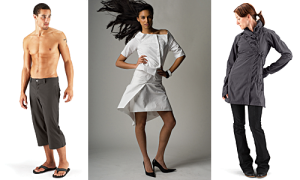Top eco clothiers share what they like about the latest crop of earth-friendly fabrics
The mention of eco fabrics once called to mind shapeless, unflattering garments. But growing numbers of contemporary designers are working with greener textiles, changing the very look and feel of fashion. From organic versions of old favorites to new, high-tech materials, here are eight fabrics that can change the impact our wardrobes have on the planet.
HEMP
The granddaddy of green fabrics, hemp is durable, grows quickly with little or no chemicals, and is more bountiful per acre than cotton. It was cultivated for millennia before becoming synonymous with hippie style, and fortunately today it’s being used to create more stylish threads.
Designer’s Take: “It’s great to sew with and is the most sustainable crop in the world, and yet growing it has been outlawed in the US for years. How can people be so stupid?” - Jennifer Ambrose, founder of Enamore
ORGANIC COTTON
Soft, versatile cotton is the world’s most popular fiber, but conventional varieties account for 10 percent of the world’s pesticide use and 25 percent of insecticides. Organic cotton helps meet global demand while preserving earthly resources.
Designer’s Take “In some countries, farmers walk around with chemical sprayers on their backs. So one of my favorite things about working with organic cotton is the difference we make in their lives.” - Marci Zaroff, founder of Under the Canopy
WILD AND PEACE SILK
Conventional silk worms are bred so they cannot survive in the wild. What’s more, they’re boiled alive in their cocoons to prevent fiber breakage. Newer varieties (called peace silk) collect silk from the wild or allow the moths to escape. Plus, plant-based dyes and handlooms keep the footprint small.
Designer’s Take “Eco-friendly silks are better for Indian weaver communities, where harsh chemical dyes are flushed into rivers. And handloomed silk employs people without requiring any electricity.” - Smita Paul, founder of Indigo Handloom
TENCEL
To create this high-tech fabric, wood chips – certified by the Forest Stewardship Council – are broken down, spun into fiber, and woven into yarn. About 99 percent of the nontoxic solvents used to manufacture Tencel are continually recycled, factory emissions are comparatively low, and the fabric is even compostable.
Designer’s Take “Tencel has the luster of silk with the comfort and softness of cotton. Plus, it evaporates water away from your body, so it’s great for activewear.” - Scott Leonard, CEO of Indigenous Designs
RECYCLED POLYESTER
Yes, it’s made from fossil fuels, but transforming trash and industrial waste into fiber is a savvy way to combat both overcrowded landfills and pollution. And because synthetic fabrics are light and waterproof, they’re unrivaled for athletic gear and raincoats. Plus, these next-generation polyesters can be recycled into new clothes again and again.
Designer’s Take “Recycled polyesters used to be rough and primitive, but now we can make lightweight, drapable, beautiful textiles.” - Jamie Bainbridge, materials research director of Nau
BAMBOO
This miracle plant grows quickly without chemicals or irrigation, and it stabilizes soil erosion. Its rapid growth sops up carbon dioxide faster than most other textile plants, and it doesn’t need to be replanted. In its greenest form, bamboo is crushed mechanically to extract the fibers and spin them into yarn, the same way linen is manufactured.
Designer’s Take “It feels silky and has a natural sheen. And it has thermal-regulating properties, so it can work as a performance fabric or just one that’s comfortable to wear.” - Morris Saintsing, Cofounder of Bamboosa
SOY
Though not as inexpensive or readily available as other textiles, soy is soft, durable, and stretchy – it’s frequently described as “vegetable cashmere.” Soy thread is typically made with by-products of tofu and soymilk manufacturing, so it cuts down on waste. Proteins from the liquid leftovers are chemically processed into the fibers used for this plush fabric.
Designer’s Take “Soy has a density to it that I like to use for casual-but-elegant pants. And certain weaves create a very wooly feeling.” - Linda Loudermilk, Designer of Linda Loudermilk
INGEO
This relative newcomer is made from corn. Cellulose fibers are extracted from the plant and spun into fabric. Some are concerned about using corn for fashion rather than food, but the manufacturing process has a low environmental impact, and Ingeo garments are compostable and recyclable. Ingeo mimics the feel of nylon and polyester, but without the fossil fuels.
Designer’s Take “It holds lines well, and you can make the textures krinkly and crunchy, almost like silk taffeta.” - Nina Valenti, Founder of NaturevsFuture
